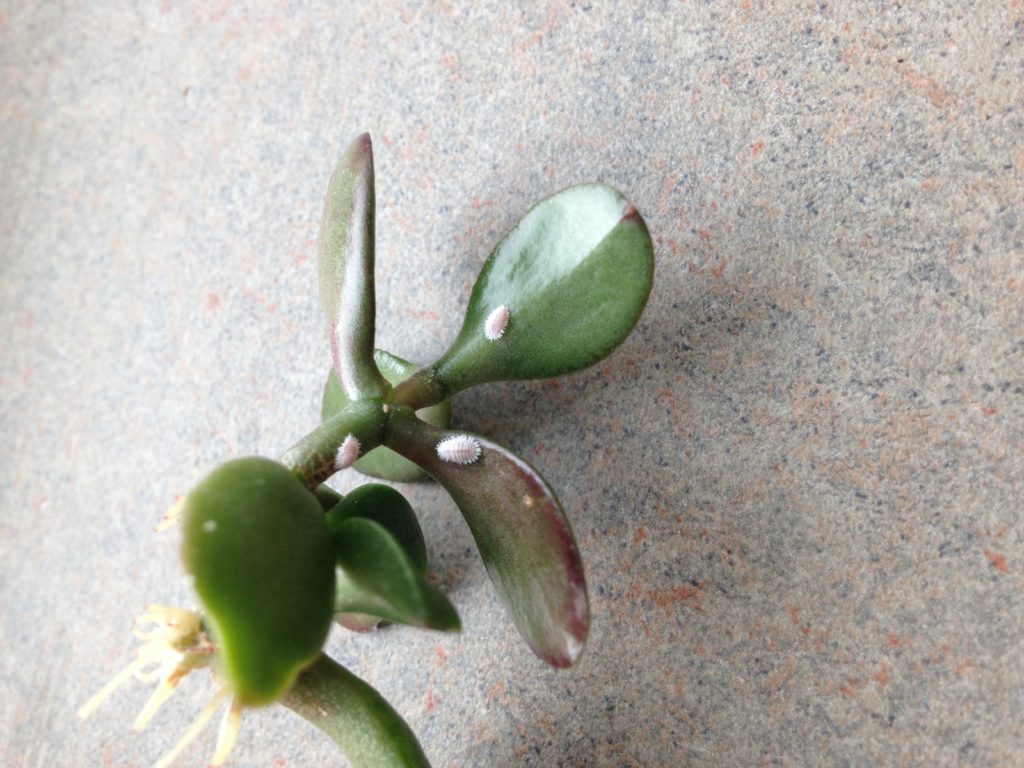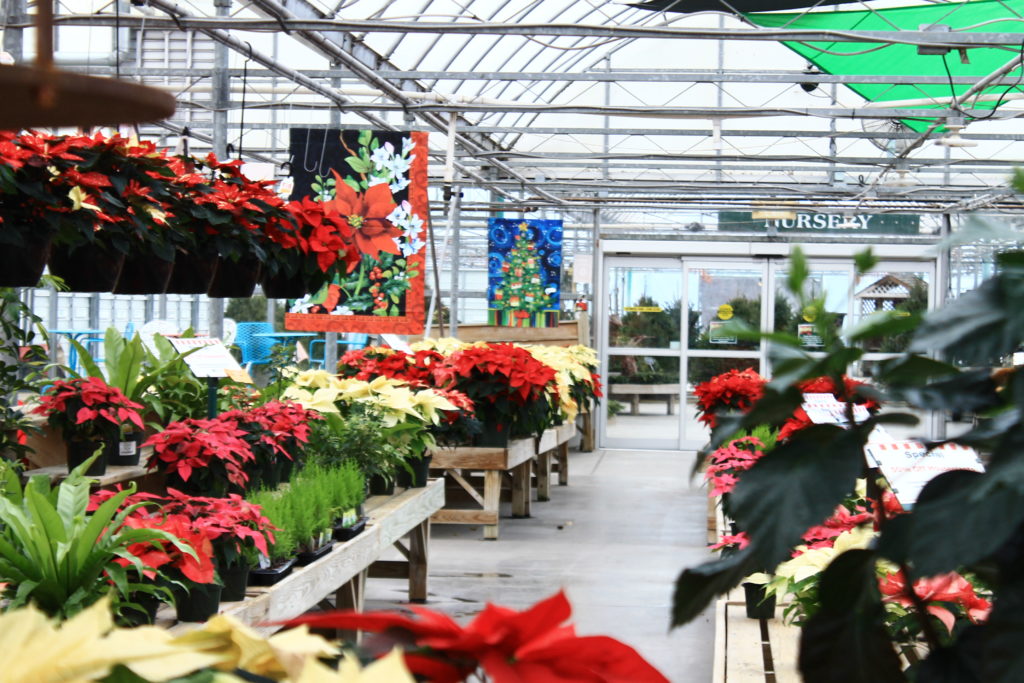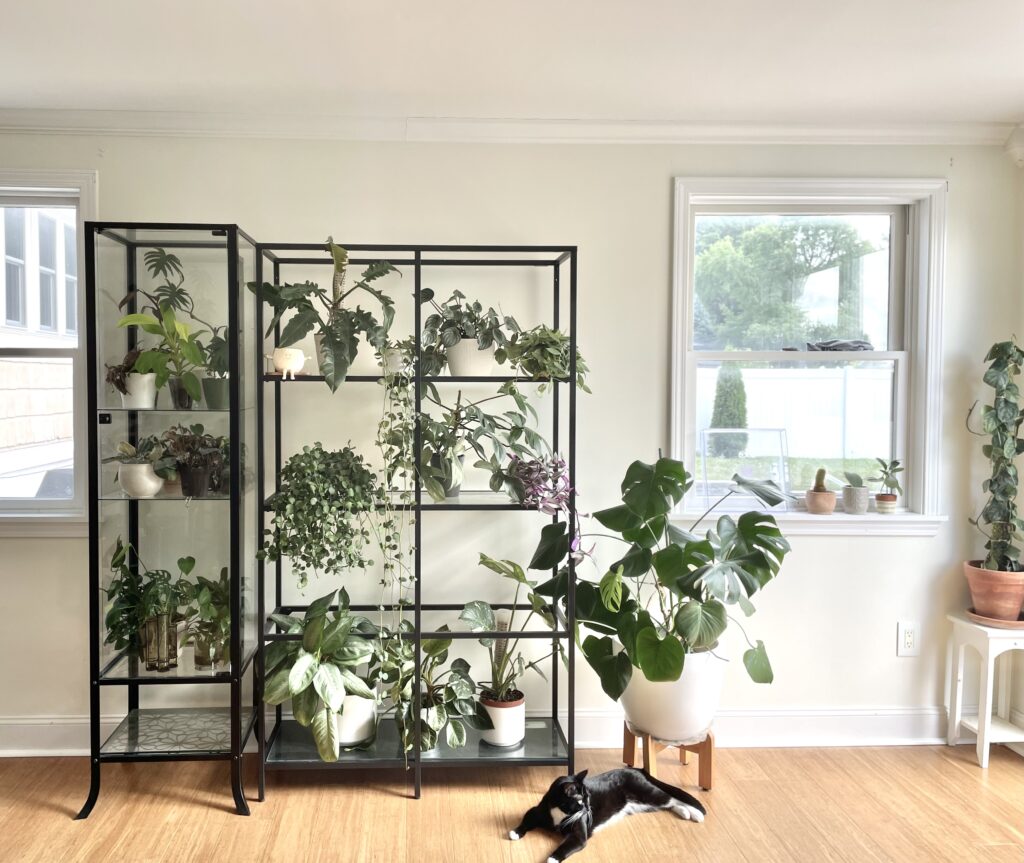
Have pets? This is how to style your indoor plants.
“I can style houseplants with pets?” you may ask in disbelief. Yes you can. While it’s not easy to train cats (or dogs) to not eat your plants, urinate in planters, and pillage healthy leaves there is hope. When plants come into your their home, a pet’s natural reaction is curiosity. Sometimes, the result is a plant pushed off table, eaten, or marked affectionately with pee. And sometimes this behavior never happens again. But nine times out of ten, this non-destroying pet doesn’t exist and it probably will.
Deep down we all want a blissful cat/dog + botanical oasis. Images of idyllic interiors of pets and plants living harmoniously flood Instagram on a daily basis but we all know the internet is a fake place full of posed photos of messy people living with normal pets. So don’t be fooled. Every cat wants to eat an entire spider plant and every dog desires to bury a raw stinky bone in a planter. Don’t be discouraged if your pet is a plant-pillaging machine. With a little lesson on houseplants styling and proper plant arrangement, you and Mittens or Fido will be basking in your oasis in no time.
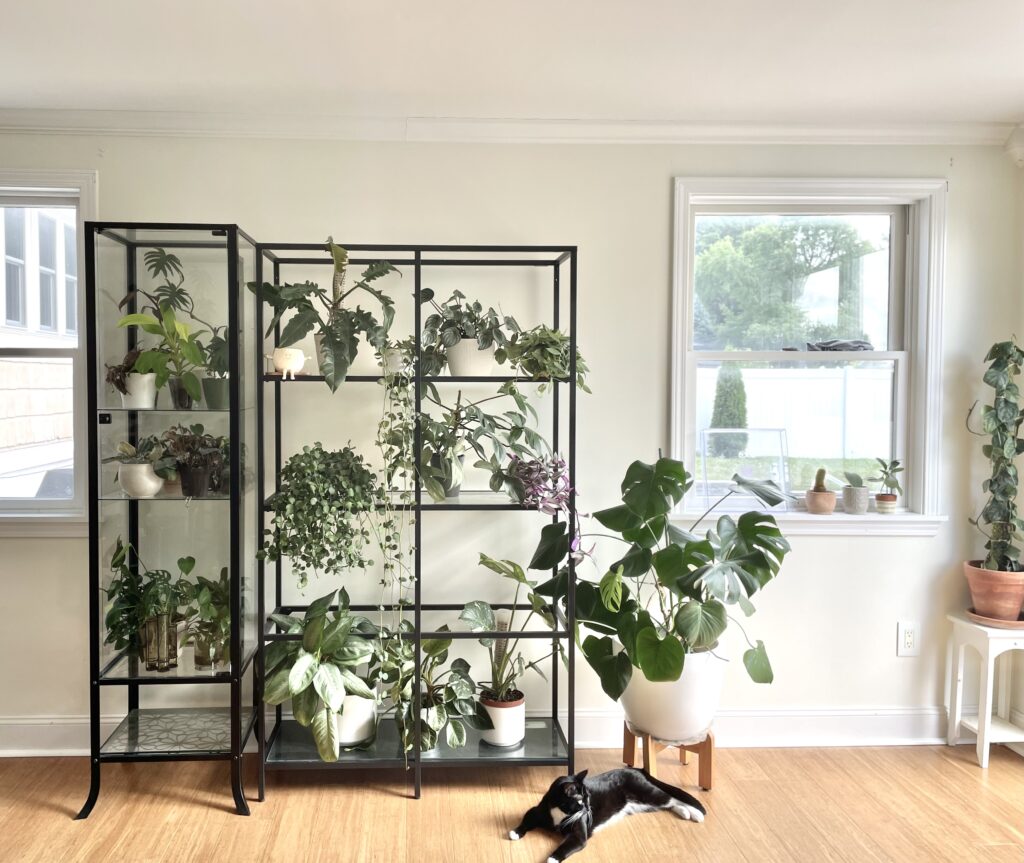
I’ve been there.
Any seasoned reader of Leaf and Paw knows I love my Monsteras, Philodendrons, and Rubber Trees dearly, despite them being unsafe for pets. I know I’m very fortunate my cats only use these plants as hiding spots for assaulting each other. I know this. My smaller plants are another story. I’m pretty strict about having only cat safe smaller plants in my home – palms, spider plants, ferns. Some of these have fallen victim to my cats, especially Harlequinn, who deeply enjoyed consuming then vomiting them up hours later. I use the past tense because she’s all grown up and now knows better. (she doesn’t)
I’ve tried multiple location arrangements for these smaller plants, factoring in their light and watering needs. Despite my love, Harlequinn always seemed to threaten to destroy it. No one likes half eaten plants and remnants all over their house – I don’t and I know you don’t either. I know I’m not alone, so I’ve come up a styling strategy that is the end our pet-induced-plant-stress. The plan? Fully scrutinize your plant placement in its entirety and rethink your indoor garden.

Step 1. Turn off Instagram right now and take a good look at your space.
There’s no point in looking at what other people are doing or where they have their plants. Remember, plants are positioned for a single moment for Instagram content, in which they are then moved back to that awkward, less-photogenic spot in the bathroom by the toilet. Your job is to take a survey of your house or apartment and visualize the best places for your plants.
Now, think – where are your plants in your home? Are they in various places by windows? Draw a picture, make a map, whatever you need. Next, write down issues you’re having with your pets and plants in your current layout. What type of problems do you face? Maybe Fluffy is snacking on leaves, digging in soil, or knocking over pots constantly. This means you currently have plants in a danger zone – they’re too accessible by your pets. And that’s bad.
2. Time to narrow down your options and find most sustainable plant placement.
With the aid of your pictures/notes, really think about these issues. What do you see? For me, I mapped out my plants and realized I no longer wanted my them all over my house, scattered. Instead, I wanted them together in clumps. One reason was to make watering easier, the other as aesthetic one. I also realized many of my trailing plants were in short, stubby planters on easily-jumpable tables and desks. Both of these issues contributed to cat-snacking, undoubtedly. Comments or observations like these will help you further to the next step.
3. Now, think about basic solutions to solve these problems.
My problem: With plants sitting on various tables, desks, and bookcases, cats can easily jump up and knock them over, regardless of height. I also wanted to style houseplants not just have plants scattered throughout the house.
My solution: I attempted to fix both problems. If a surface is full enough of plants, this should deter my cats from jumping up. So, my plan was to make space in my home to house many plants in a single location. I put a small rectangular table near a window for sunlight and crossed my fingers. Hopefully this would stop the jumping and feeding frenzy too.
I also realized – Harlequin won’t touch my peperomias. The wavy thick leaves are just not appetizing, so, I arranged this table with peperomias on the outer edges. This bench was pretty full, and since creating this family, I haven’t had any issues with jumping. And here, they get all of the light they need in this South facing window. Maybe you have one plant (pet safe) that your cats avoid? This can be a good idea for you too.
The verdict was that this did work for me, this table idea. I didn’t like the look of it and that’s ok! Time to pivot. I instead bought an IKEA Vittsjo unit and LOVE it. I also use IKEA carts (more about plant placement and carts here) a lot. This whole set up works a lot better for me.
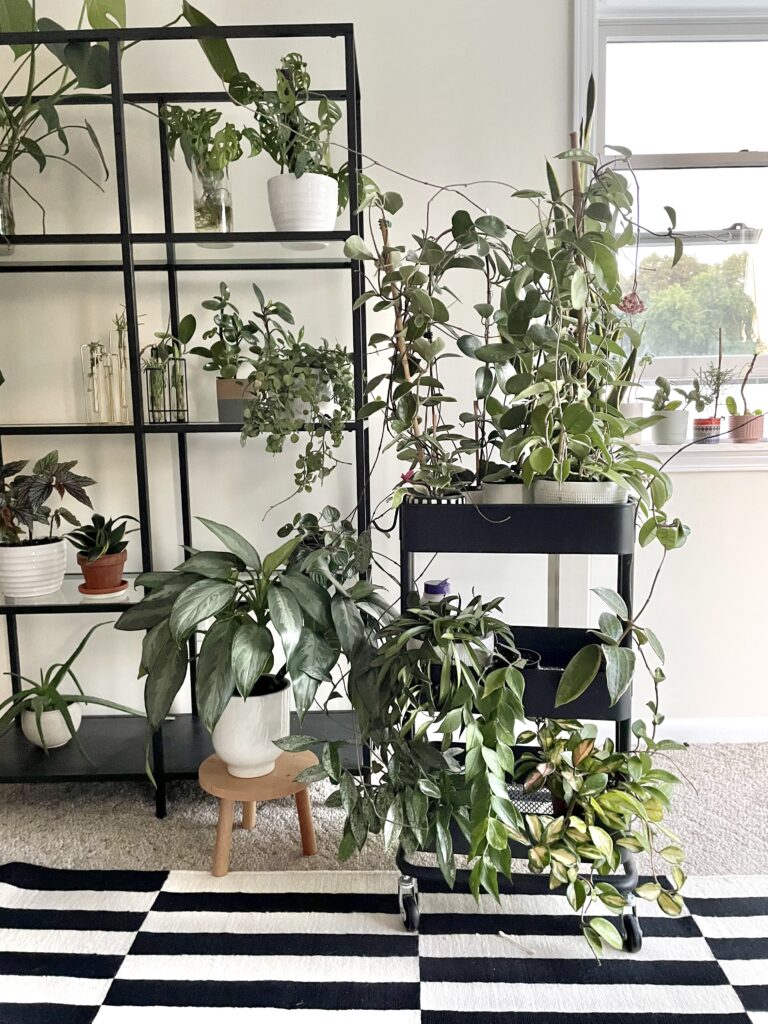
4. Go a step further with problem solving.
After clustering all of my plants I needed a place for them to go. I made a decision to end my woes – no matter if a plant is low light or bright light, they all go near a sunny window. At the end of the day, all of my plants flourish way better in bright/indirect light; there really isn’t a plant that doesn’t like light. This rule allows me to no longer have small plants in a million corners of my house (which also makes watering time consuming). This can be as simple as my solutions – clustering plants all together, hanging trailing plants from the ceiling instead of a shelf, putting floor plants on plant stands, and so on.
5. Ok, here are some other options to style houseplants.
I know what you’re thinking – that’s not ideal for everyone. Some people don’t have windows with great light and others may still have issues with pets eating them. The next step is finding other solutions that involve buying something to solve the problem.
Lighting: If lighting is your issue (or lack thereof) I love Soltech lights. Soltech is the top of the line but a decent sure is this hanging light. There’s also these stick on lights which stick to shelves or these lights that can go into large planters.
Hanging planters: You can easily turn any standard planter into a hanging planter with a macrame plant holder. These go over your pots and can be suspended from a ceiling hook.
There are some pretty hanging planters too, if you don’t mind repotting the plant. They keep plants off the ground, and even non trailing plants look lovely in them. Just be sure they can still get a decent amount of light. A simple trick is placing a hanging planter near a window or near a mirror – the refection helps brighten the space. Mirrors and white walls are amazing at making a space brighter and bigger for plants. Young cats also like to stare at themselves for hours in mirrors, I’ve found, and it’s weird.

Large standing planters: Monty, Filbert and Rudy all sit in giant planters. I’m lucky my cats chose not to dig in the dirt, but for those who do, large planters can be difficult.
A couple things you can do:
-Rocks over the soil prevents digging/burying/destruction, plus it increases humidity. I have purchased these black rocks in the past and still use them.
–Moss too works as a deterrent. Its actually something I use a lot in clients homes for metering pets for just making things looks fancy. Just be careful as some cats may try to eat it and/or still choose to destroy said soil. I like sheet moss but sphagnum moss also works.
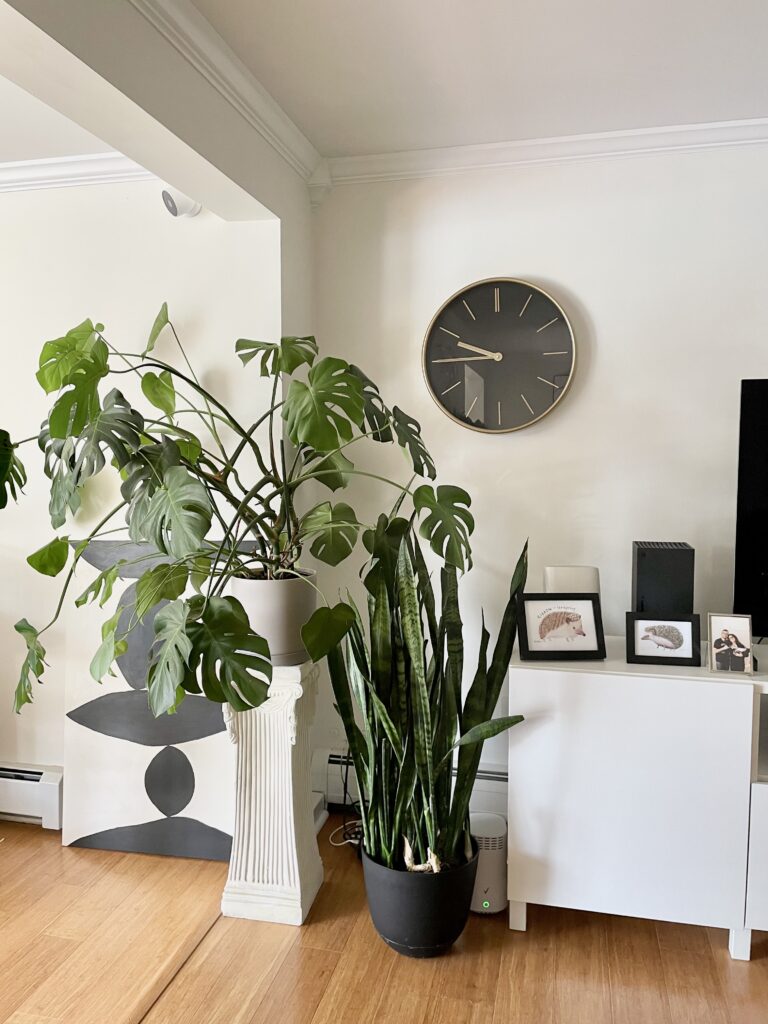
Plant Stands: This is the direction I went to, as I like having my plants on their own kind of structure. Amazon has a great selection of smaller stands but honestly places like CB2, Marshalls/Homegoods and Urban Outfitters have super cute ones. Just make sure they look sturdy and are not garbage, after all it’s like a car seat for your plant baby. Small tables work to arrange plants, too, but if you like height, one of these plain metal shelving units is another great option.
Personally, I really try not to buy anything extra, so before you go out and purchase five $80 plant stands, see if you can make your current situation work with what you own.
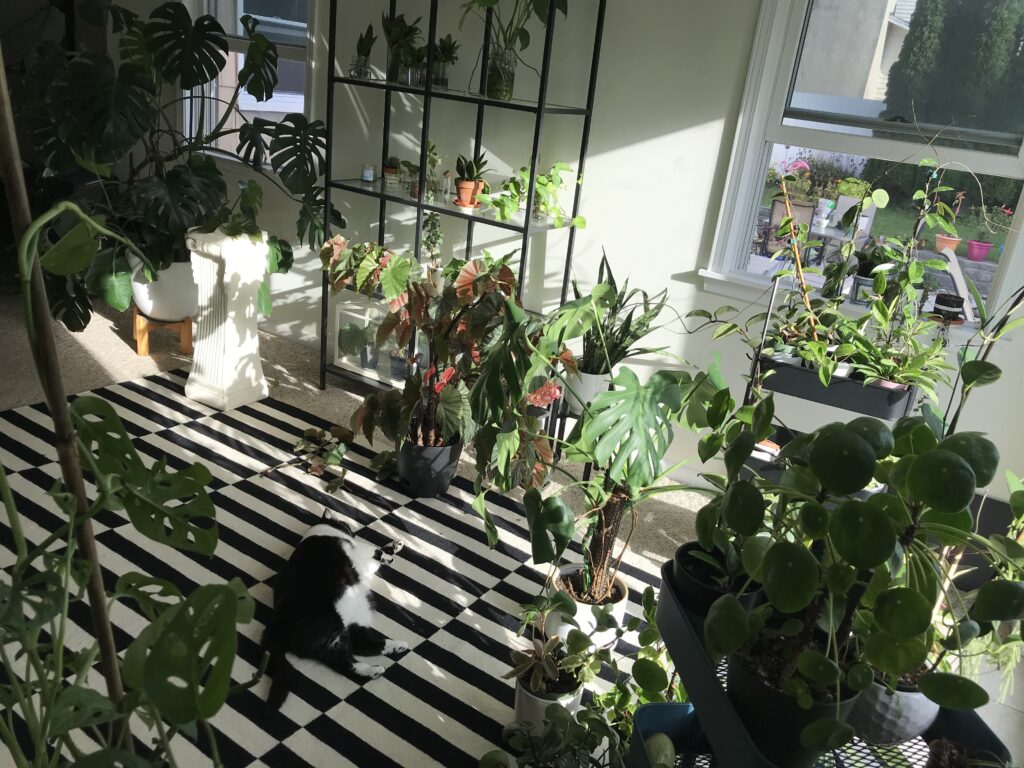
The Results:
After all of this moving about, my intention of a jungle that’s easy to maintain succeeded. As plant collections grow, reassessment obviously will need to happen, but that’s ok. For serious animal and plant lovers, the most important step is creating a home for your furry and leafy babies to thrive.

